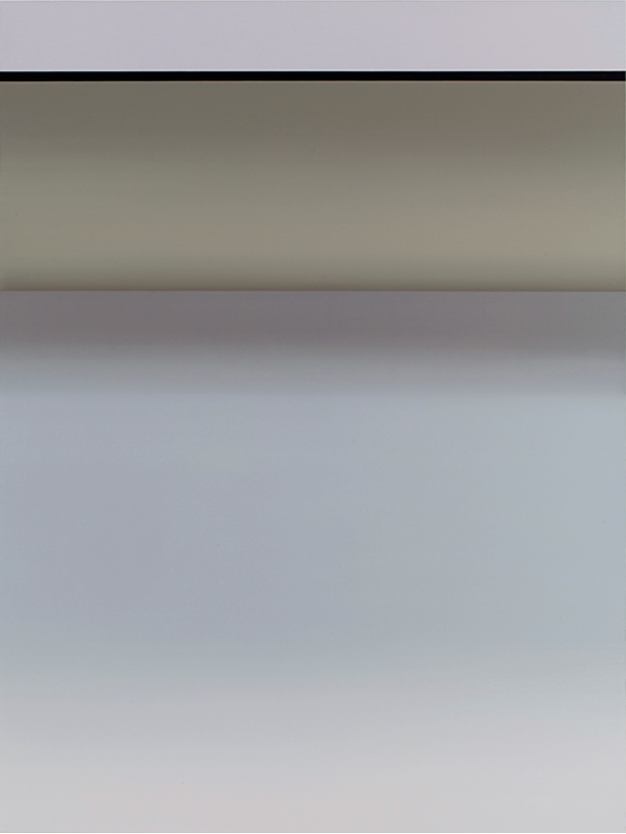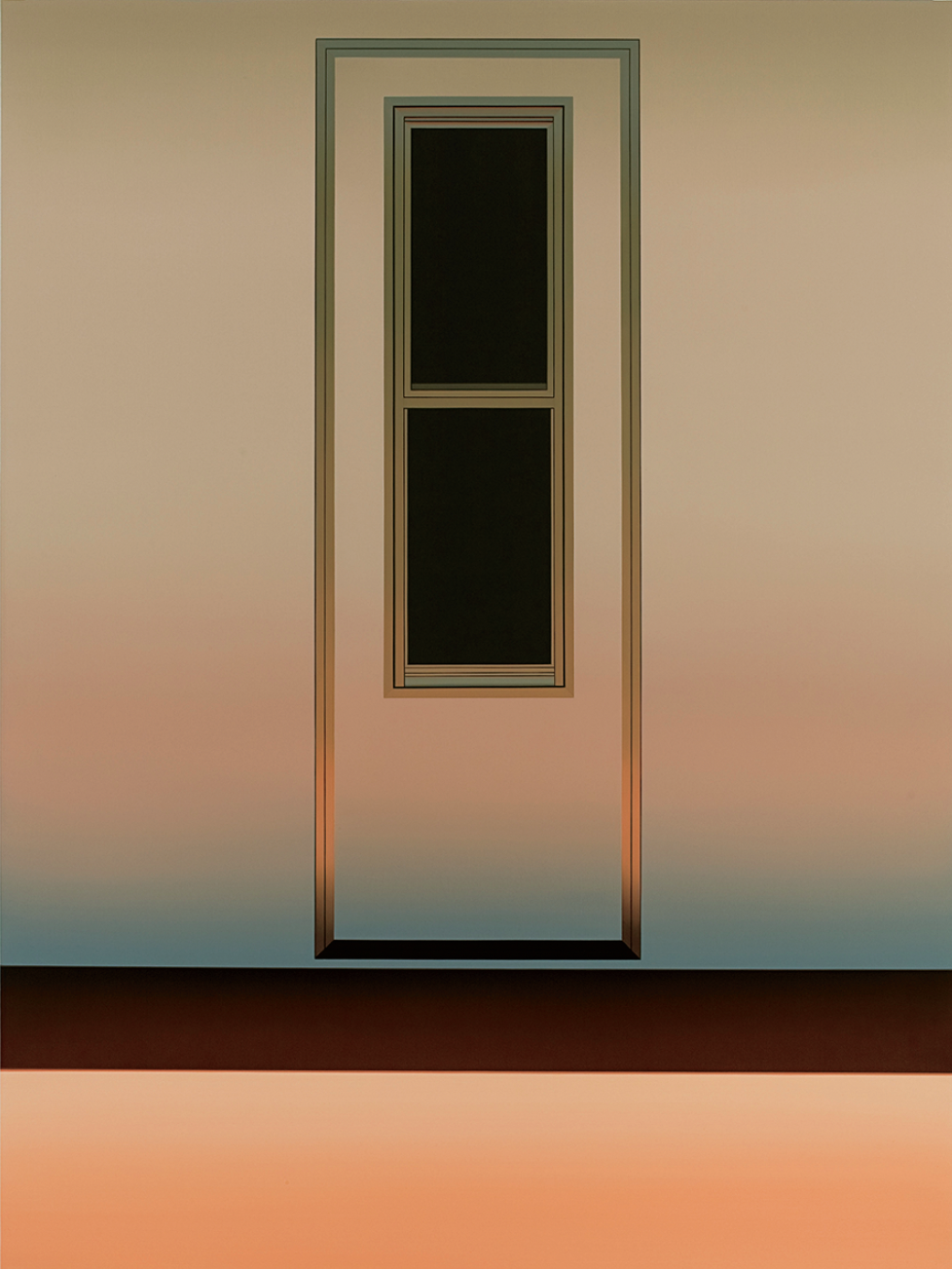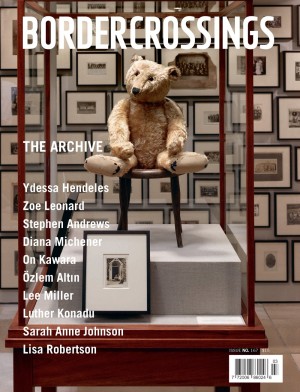Pierre Dorion
That feeling of ennui, banality, morbidity—it comes right from the colour. As Baudelaire says, “colour thinks for itself,” and this colour is certainly thinking, and doing so in the darker ranges of reflection. This is colour and surface crushed under a mysterious weight, all its breath squeezed out by the great weight of various architectures. Back in the ’80s when Pierre Dorion’s paintings were situated within the problematics of figuration, his works were so dark as to leave one with nightmares. Mes Confessions, 1985, would be an excellent example of this funereal register.
Montreal Museum of Fine Arts curator Stéphane Aquin brought together a surprising combination of two bodies of new work by this Montreal artist, one consisting of small photographs, the other of large-scale paintings. Simultaneously, down the street at Galerie René Blouin there was an additional selection of related large-scale paintings by Dorion belonging to the same period. Although the two bodies of work—photographs and paintings—are parallel to each other in many ways, we experience the two tracks as radically divergent, even contradictory. If there is here an intersection between painting and photography, it follows from this divergence, one rooted in Dorion’s life-long commitment to the painterly resource of the pictorial played against abstraction, or perhaps it’s the other way round.

Pierre Dorion, Untitled (Moma), 2009, oil on canvas, 182.9 x 137.2 cm. Photograph: Richard-Max Tremblay. Courtesy Galerie René Blouin, Montreal.
Both bodies of work presented relationships with architecture. The photographs, digital images printed on photo paper that are less than four by six inches each and rest behind individual sheets of glass, present abstracted fragments and details of buildings. They are characterized by their geometric precision, their attention to the division of space in terms of diagonal, horizontal and vertical compositional elements. However, what is perhaps most remarkable is their attention to lighting and its gradients. Dorion’s vocabulary of lighting includes distinctions of soft/hard, reflection, shadow, flat versus reflective and, especially, distinctions of surface texture as revealed in lighting. In terms of spatial configurations, Dorion observes and presents “illusionistic” effects of open versus closed spaces where each may appear to be its other.
These tiny photographs, 40 in this series, are beautifully simple, highly refined and inform each other with precision. However, what is most interesting is the way they reflect on their status as photographs, and this occurs on the basis of their inclusion in this exhibition with the artist’s paintings, which in many ways appear to be derived from photographs such as these. As a reflection on photography, these images reveal just how “sealed-in” by the uniformity and continuity of their surfaces a photograph essentially is due to its machine production. In Dorion’s photos, we see their relationship with gesture and tactility subordinated to surface. Even though their principal aspect as photographs is the deathliness arising from their style of production, there is no way that this can be photographically presented. It has to be done from the outside. This is where the paintings arrive on the scene.
Although initially these paintings appear to be derived from photographs like those presented, phenomenologically the relation is not as direct as we might expect. Of course the scale of the paintings is much different from the tiny photographs, being up to at least six feet by eight feet in many cases. As with the photographs, the paintings are ambiguously abstract, concerned with divisions of space, shapes and relationships between surfaces and colour, but with nuances of reference to built spaces. Nevertheless, a difference nags us, a disturbance that gets under the skin. Like the photographs, the paintings play differences of lighting, shadow and surface against one another, even taking into their scope the electrical lighting of the museum as it splays down the walls from the ceiling and as it bends to the contours of the museum corners. This continuity grates with a sense of banality, as repetitions often do, and this “annoyance” gives the paintings more edge than one would expect. The impact of Dorion’s colour is equally profound, being based in the grey-beige, grey-brown, blue-grey ranges of an almost retro sensibility. The putty tones enhance a feeling of being inside a past narrative, a space of memory that belongs more to the realm of photographs.

Pierre Dorion, Red Cabin, 2009, oil on linen, 182.9 x 137.2 cm. Photograph: Richard-Max Tremblay. Courtesy Galerie René Blouin, Montreal.
These paintings are compositionally sparse, having few elements, and these elements consist of surface areas of either consistent colour or of surfaces that “suffer” gradations in colour and tone. And yet, even though the abstract aspect of these paintings is constant, there exists a subtle intrusion from the region of the technical image: traces of photography penetrate the field of painting and kill it dead, leaving canvases that rest in the past. Like the photographs, these paintings have a morbidity reminiscent of the stories of Austrian writer Thomas Bernhard or the paintings of Edward Hopper, and even De Chirico, but unlike the photographs, these paintings actively bear their difference from life in the open temporality that is the nature of drawing and painting, surfaces traced by human touch that are perpetually unfolding in the present. And although touch is an important aspect of all the paintings, there is an absolute lack of expressionist gesture. Like the photographs, they are resolutely precise, tight, exacting.
Where I would ultimately locate the relationship of the photographs and the paintings is in their modes of temporalization. The “infinitude” of painting is something Dorion demonstrates by combining and juxtaposing it with his photographs. By bringing a painting to a full stop, Dorion aligns it with a photograph and reveals the difference. The permanence of a photograph is something fixed, while the permanence of a painting is something open, a permanently unfinished perception, an infinite.
The results of Dorion’s immensely impressive attainments in the field of painting are presented with great clarity in his disruptions of the pictorial tradition. Paradox is often at the heart of any perception of both Dorion’s photographs and his paintings. The photographs are elegantly refined little gems of abstract composition that retain their identity as fragments of our everyday built environments. The paintings are subtle subversions of abstraction that insert the most personal and human dimensions of emotional experience just where we find ourselves encountering the purity of geometric abstraction. The morbidity that is part of Dorion’s painting is similarly a paradox whereby a space of otherness and difference is opened. ❚
“Pierre Dorion” was exhibited at Galerie René Blouin from April 10 to May 15, 2010, and “Pierre Dorion, Painting and Photography” was exhibited at the Montreal Museum of Fine Arts from March 4 to May 30, 2010.
Stephen Horne is an artist and writer based in Montreal.

